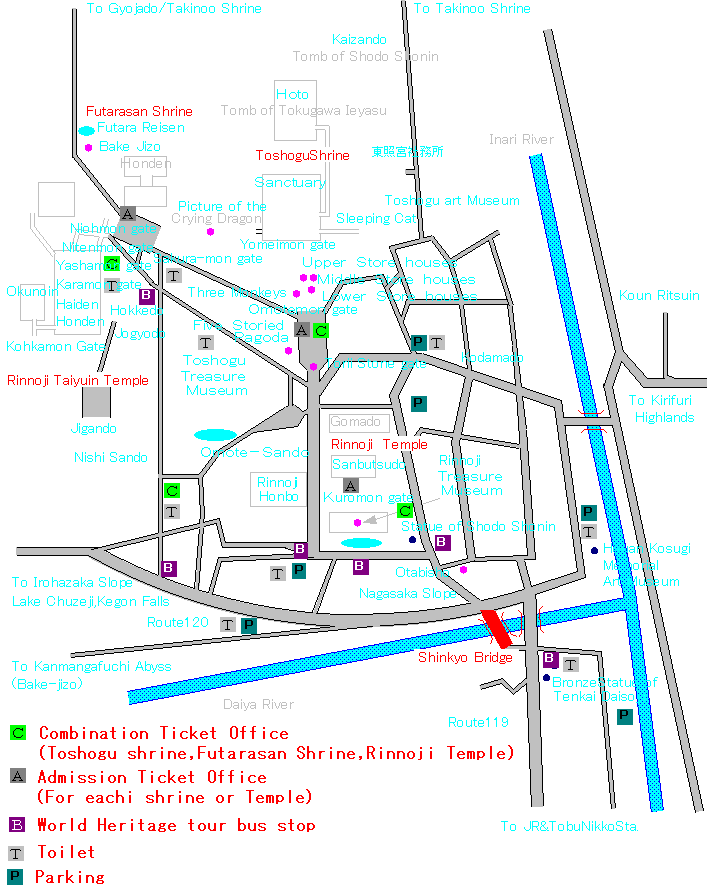
|
The shrine is the mausoleum of Tokugawa Ieyasu , the first Tokugawa Shogun , who ruled Japan from 1603 to 1616. Ieyasu died in Sunpu inShizuoka on April 17,1616.He was first buried at Kuno-zan in Shizuoka,but in accordance with his last will , his remains were transferred to Nikko in the following year. He said in his will"When I die , bury me at Kuno-zan first. Then after a year , build a small shrine in Nikko and bury me there. I will be a guardian god and watch all over Japan.
The constructaion of the mausoleum was performed by Tokugawa Iemitsu ,
the grandson of Ieyasu and the third Tokugawa Shogun. The construcyion
work was begun in 1634 and finished in 1636. Almost all the construction
of the mausoleum.
The shirine is said to have been completed in only seventeen months at
a cost $53,000,000 in modern-day money. The shrine is constantly undergoing
mintenance and repair.
The immense amount of gold-leaf used in the buildings coupled with numerous
elaborate carvings enhance the beauty of the shirne.
|
| 主な伝統行事 |
| Jan |
1 |
歳旦祭 |
|
2/3 |
新年献饌祭 |
| Feb |
3 |
節分祭 |
| |
11 |
紀元祭 |
|
17 |
祈年祭 |
| Apr |
14 |
酒迎式 |
| May |
17/18 |
春季例大祭(17日 流鏑馬神事 他 / 18日 百物揃千人武者行列(1000명 무사 행렬) 他) |
| Jun |
30 |
大祓式 |
| Oct |
17 |
秋季大祭 |
| Dec |
20 |
御煤払 (大掃除) |
|
31 |
除夜祭 |
|
| |
|
A group ticket(More than 35 people)
|
|
|
1,300Yen
|
1,170Yen
|
|
|
Elementary & Jr.high
students
|
450Yen
|
405Yen
|
| ■Hours open to the public |
From April to October , 8 a.m. to 5 p.m. (Last entry :16:30)
From Nobember to March , 8 a.m. to 4 p.m.(Last entry :15:30) |
| ■Worship point |
The points that are opened to the public from Karamon to Okusha(It is included
Okusha , Sliiping cat and Nakiryu)
|
■In the case of Combination Ticket use
|
| Separate payment |
Adult
|
Elementary & Jr.high
students
|
| Higasi Kairoh(Sleeping cat),Okusha |
520Yen
|
370Yen
|
| ■Treasure Museum |
Phone 0288-54-2558
|
| |
Ticket
|
A group ticket(More than 20 people)
|
|
Adult
|
500Yen
|
400Yen
|
|
High school
students
|
300Yen
|
240Yen
|
|
Elementary & Jr.high students
|
200Yen
|
160Yen
|
| ■Hours open to the public |
From April to October , 8 a.m. to 5 p.m. (Last entry :16:30)
From Nobember to March , 8 a.m. to 4 p.m.(Last entry :15:30) |
| ■Art Museum |
Phone 0288-54-0560
|
| |
Ticket |
A group ticket(More than 30 people)
|
|
Adult
|
800Yen
|
640Yen
|
|
High school
students
|
600Yen
|
480Yen |
|
Elementary & Jr.high students
|
400Yen
|
320Yen
|
| ■Hours open to the public |
From April to October , 9 a.m. to 5 p.m. (Last entry :16:30)
From Nobember to March , 9 a.m. to 4 p.m.(Last entry :15:30)
|
| 春季例大祭:Grand Spring Festival |
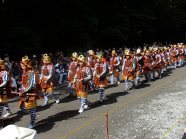 |
The Grand Spring Festival is held annually by Toshogu Shrine from May 17th
to the 18th. The festival is a reenactment of the ancient procession when
the soul of Ieyasu Tokugawa , the first Shogun , was moved from Kunozan
to Nikko. A 1200 samurai warrior procession parades down a 1km long street
and horseback archery (yabusame) displays are held. |
|
| 陽明門 Yomeimon Gate |
 |
Yomaimon Gate is one of the representataive buildings in Toshogu Shrine.
It is popularly called Higurasi-Gomon (a day -spending gate). It is 11.1meters
in height , 7meters in width and 4.4meters in depth. It faces due south.
it is decorated with as many as 508 exquisite carvings. You can spend a
whole day in front of this gate and never get tired of looking at it.That
is why the gate is popularly called "a day-spending gate." |
| 魔除けの逆柱 Mayoke Bashira(Column to avert evil spirits) |
 |
The 12 columns that support the gate have whirling patterns on them. The
patterns on one of them , however , were purlosely carved upside-down to
turn away the attention of evil spirits who are aiways jealous of perfection
and are ready to destroy "perfect" things.
The column is called Mayoke Bashira(column to avert evil spirits) or Sakasa
Bashira (upside-down column). |
| 唐 門 Karamon Gate |
 |
The Karamon Gate is the gate leading to Honsha(Sanctuary).The gate is a
small building which is 3 meters in width and 2 meters in depth. Though
small , it is decorated with 605 carvings.
Just under the roof of the Karamon Gate , we can see carvings of 'An audience
with Emperor Shun' , 'Seven Wise Men in a Bamboo Grove' , 'Kyoyu and Sofu'
, etc.
|
| Naki Ryu (Crying Dragon) |
 |
The Naki Ryu is painted on the ceiling of Yakushi-doh (Or called Honji-doh)
Hall , which is located on the back of Korou (Drum tower). It makes a sound
like a crying when clappers are struck under the dragon. The original picture was
painted by Yasunobu Eishin, but was restored by Nanbu katayama after it was
burned down. |
| 眠り猫 Nemuri Neko(Sleeping Cat) |
 |
The panels along the corridors extending right and left from Sakashitamon
Gate are decorated with over 300 exquisite carvings of plants and animals.
The most famous one is the carvings of Nemuri-neko(sleeping Cat) , which
is said to have been carved by Jingoro Hidari. Nothing is known about Jingoro.
Behind the sleeping cat there is a carving of two sparrows playing peacefully
in a bamboo grove.The carving of sparrows playing near the cat may be interpreted
as symbolizing the peaceful world brought about by Tokugawa Ieyasu. |
| 三 猿 Three Monkeys |
 |
On the wooden panels of the Shinkyu sha(Sacred Stable) , there are eight
carvings of monkeys , each representing a different phase of life.The most
famous one is the carvings of three monkeys , who tell us a lesson that
children should "See-no-evil , say-no-evil and Hear-no-evil".
Monkey carvings were used to decorate the stable because monkeys
|
| 五重塔 Five Storied Pagoda |
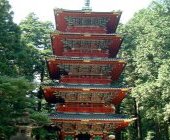 |
This five-storied pagoda was presented by Sakai Tadakatsu , feudal lord
of Obama(now Fukui Prefecture) , in 1649on the 33rd anniversary of Tokugawa
Ieyasu's death.
The first foer stories were built in Japanese style and the top story in
Chinese style. If you look up the pagoda and look carefully , you can see
that the refters of the first four stories run in parallel while those
of the top story run radially. |
|
|
이 Page의Top에 |
| 日光山輪王寺 Nikko-san Rinnoji Temple http://www.rinnoji.or.jp Phone +81-288-54-0531 |

|
| The origin of Rinnoji Temple dates back to the year 766 when Shodo Shonin
built Shihonryuji Temple on the left bank of the Daiya River. During its
long history of more than 1200years , the name of this temple was changed
several times. This temple once belonged to the Shingon Sect of Buddhism
, but now it belongs to the Tendai Sect. |
| 主な伝統行事 |
| 1월 |
1일 |
歳旦会(정월제) |
|
3일 |
外山毘沙門天縁日 |
| 2월 |
3일 |
節分会(절분) |
| 4월 |
1일 |
開山会(勝道上人:命日) |
|
2일 |
強飯式 |
| 5월 |
17일 |
延年舞 |
| 8월 |
중순 |
薪能 (演目・日程は年ごとに異なるので要問合せ) |
| 11월 |
25일 |
子供強飯式(於;生岡神社) |
| 12월 |
31일 |
越年護摩 |
|
| A |
■Nikko-san Rinnoji Temple |
|
|
|
| |
Ticket
|
A group ticket(More than 35 people)
|
|
Adult
|
900Yen
|
810Yen
|
|
Elementary &
Jr.high students
|
400Yen
|
360Yen
|
| ■Hours open to the public |
From April to October , 8 a.m. to 5 p.m. (Last entry :16:30)
From Nobember to March , 8 a.m. to 4 p.m.(Last entry :15:30)
|
| ■Worship point |
Inside of Sanbutsudo・From Nio-mon gate Taiyu-in shrine to Haiden &
Ko-kamon gate |
| ■A Ticket of Sanbutsudo(三仏堂) |
| |
Ticket
|
A group ticket(More than 35 people)
|
|
Adult
|
400Yen
|
360Yen
|
|
Elementary &
Jr.high students
|
200Yen
|
180Yen
|
| ■Worship point |
Inside of Sanbutsudo
|
| ■A Ticket of Treasure Museum(宝物殿)・Shouyouen(逍遥園) |
| |
Ticket
|
A group ticket(More than 35 people)
|
|
Adult
|
300Yen
|
270Yen
|
|
Elementary &
Jr.high students
|
100Yen
|
90Yen
|
|
| 勝道上人 Priest Shodo Shonin |
 |
After about a 5 minute walk from the Sacred Bridge(Shinkyo Bridge) , you'll
see the statue of priest Shodo-Shonin. The statue is gilded bronze , 8
ft.tall and stands on a stone pedestal 13 ft. high. It marks the entrance
to the Rinnoji Temple.
Shodo is a central figure of the prosperity of the Mt.nikko faith to assume
Mt.nikko the Bible. |
| 三仏堂(大本堂) Sanbutsudo |
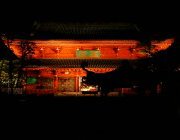 |
Sanbutsudo is the largest building in Nikko Sannai area. It is Important Cultural Property.
The name Sanbutsu-do comes from the three big Buddhist statues in the building. |
| 木彫三仏座像 |
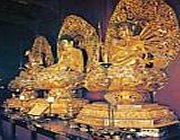 |
Sanbutsu can be translated as three Buddha. In fact, three images of Buddha
are enshrined inside. According to a historical record of temple, Ennin
Saint Jikaku built the Sanbutsu-doh Hall by referring to Konponchu-doh
Hall of Mt. Hiei. He enshrined Bato Kaonnon, Amida Nyorai and Senju Kannon
in Sanbutsu-doh Hall. These images are representatives of Mt. Nantai, Mt.
Nyohou and Mt. Tarou. Saint Jikaku's contribution was based on mountainous
worship. |
| 相輪橖 Sohrintoh Tower |
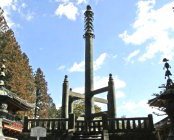 |
The Sohrintoh Tower is bronze , is 13.2m high and is located near the Sarbonmatsu-doh
Hall. 24 bells and ornament of Kinyoraku decorate upper side of the tower.
On the contrary , you will find three hollyhocks on the lower side of the
tower. Hollyhock is fammily crest of Tokugawa. 4 subordinate pillars support
three hollyhocks. In1643 , Bishop Tenkai built this tower because the third
successive shogun Iemitsu made a vow. The Sohrintoh tower referred to the
first building that Saint Saicho of Tendai sect built. that first tower
is located in Enryakuji Temple of Mt.Hiei. |
|
|
이 Page의Top에 |
| 大猷院 Taiyuin Temple |
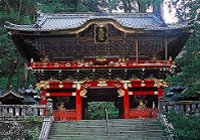
|
| A mausoleum built in 1653 for Iemitsu Tokugawa , the 3rd Shogun of the
Tokugawa Shogunate. Out of respect for his grandfather enshrined in Toshogu
Shrine , Taiyuin was built with less splendor , yet you can still see how
the architectural style shouws a higher degree of maturity of the arts. |
| |
Ticket
|
A group ticket(More than 35 people)
|
|
Adult
|
550Yen
|
495Yen
|
|
Elementary &
Jr.high students
|
250Yen
|
225Yen
|
|
| ■Worship point |
From Nio-mon gate(仁王門) Taiyu-in shrine to Haiden(拝殿) Ko-kamon gate(皇嘉門)
|
|
|
| 大猷院家光廟(唐門) Taiyuin Mausoleum(Karamon Gate) |
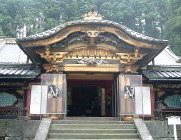 |
Kara means Chinese style. It is 3m high, and frontage
is1.8m. The Karamon Gate is the smallest building in Taiyuin Mausoleum,
but sensitive and elegant works are put on. Two pillars have been made of
zelkova tree, and are not exposed to outside. That gate is decorated by metal
fittings. Some are colored by black, and some others are transparent.
|
| 大猷院家光廟(皇嘉門) Taiyuin Mausoleum(Kohkamon Gate) |
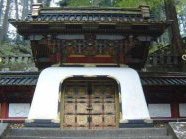 |
The Koukamon Gate has a function as the border between Okunoin (Inner House)
and other buildings. The Okunoin is not open to the public. The name of
the Koukamon was the same as one of the twelve gates, which existed in the palace at
that time. The Koukamon Gate is 2.2m high, and 1.8m wide. It is relatively
small in this area. Construction of Koukamon Gate is Ming dynasty (Chinese)
style. It also is called Ryuugu-zukuri (Palace of sea God.) Therefore,
this gate is also called Ryuguumon Gate.
|
|
|
|
| 日光二荒山神社 Nikko Futarasan Shinto Shrine http://www.futarasan.j Phone +81-288-54-0535 |

|
The Futarasan Shrine is the oldest among the shrine and temples in the
Nikko. The present building , however , was constructed in 1619 by Tokugawa
Hidetada , the Second Tokugawa Shogun. In the Oratory , armors and other
historical treasures are on display.
Mt.Futara ,
|
| 主な伝統業行事 |
| Jan |
1 |
歳旦祭 |
| Feb |
1~3 |
節分祭
3日 ガラ蒔き |
| Apr |
13~17 |
弥生祭 |
|
|
|
Every
manth |
secand
Sat |
だいこくまつり(12月を除く) |
|
|
| A |
■Nikko Futarasan Shrine |
| ■Hours open to the public |
From April to October , 8 a.m. to 5 p.m. (Last entry :16:30)
From Nobember to March , 9 a.m. to 4 p.m.(Last entry :15:30)
|
| |
Adult
|
Elementary &
Jr.high students
|
|
本社神苑入園料
(化灯籠含む)
|
200Yen
|
100Yen
|
|
日光神楽
|
500Yen (More than 10 people) |
|
特別参拝神楽
|
1,000Yen (More than 10 people)
|
| 弥生祭 Yayoi Festival |
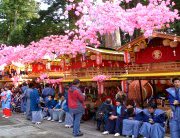 |
| This festival with a 1200year tradition is held annually by Nikko Futarasan Shrine for 5 days from April 13th to the 17th. On the 17th , people in historic costumes together from 12towns and floats plus traditional music are on display. In this wonderful atmosphere miniature shrines are also carried around , especially on the 16th and 17th. |
|
|
| 神 橋 Shinkyo Bridge |
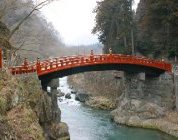 |
Shinkyo is beautiful red-lacquered bridge across the Daiya-gawa River.
It is 28meters long. According to the legend, when the priest Shodo, the
founder of Nikko first came to Nikko with his followers, a god helped them
to cross the rapid currents with his two snakes. They entwined themselves
into a bridge. |
| 二荒霊泉 |
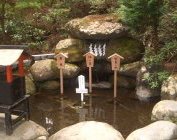 |
The Futara Spiritual Spring is located after you passed the Torii gate of Mitomo
Shrine. The water comes from cave of Mt. Korei, which is located on the back of
Honden main hall. People believe that spring has two effects. That water might
have a spiritual effect on eye disease. In addition, that water makes a tasty
sake.
Ceremony for the completion of pond
was taken on October 13th in1971. The water is transparent and colorless, water
temperature is 12 Celsius degree, no bacteria, and hardness is 26.68 as a result
of examination. That number tells us that the water is adequate to
drink.
|
| 胴灯篭(化け灯篭) Bronze Lantern(Gobrin Lantern) |
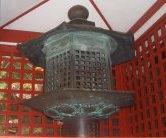 |
When you proceed to the rear of the Oratory , you'll see a bronze lantern
on the left , outside the fence enclosing the Main Hall.
This lantern is called "Bake-Doro" , or"Goblin Lantern."
It has scars showing thet it was once struck by a sword. People say that
at night it looks a goblin. |
|
|
|
This Page Top |
|
